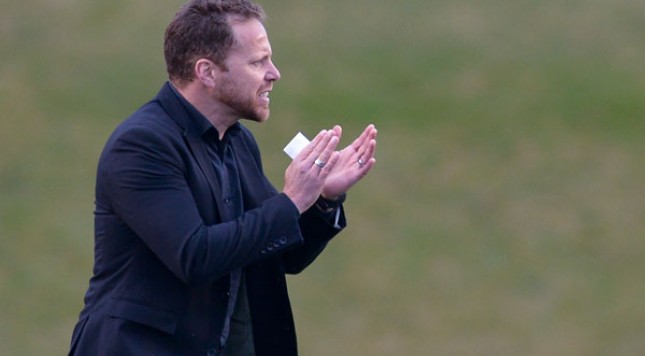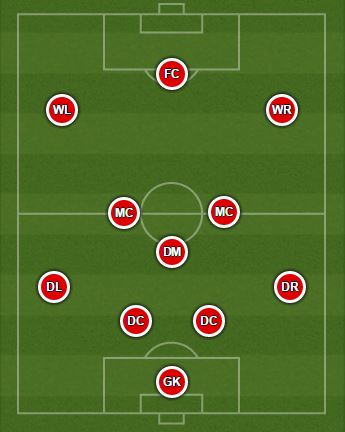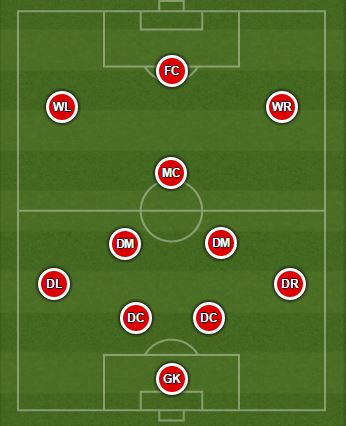Marc Dos Santos loves talking about football, which isn’t surprising considering his career path. I had an opportunity not too long ago to sit down with the Fury’s head coach where we talked about the system he’s implemented in his time in Ottawa. Keep in mind that he was speaking on the record, but that he was honest in that he wasn’t going to divulge his every secret for competitive concerns.
Right from the start, Dos Santos very quickly points out that a formation, or a system as he calls it, is really only a media construct and that without the philosophies that are implemented into the positioning of players, it’s only a bunch of dots on a page. He explains it this way: “I think that systems are very good for the media, especially good for TV, but they have no life. A system is like a dead body; it has no soul, no spirit. You’re dead, you know? So you have to breathe life into this system.”
The team setup preferred by Dos Santos is what he calls a 4-3-3 Wide. Not every 4-3-3 Wide is the same, however, as he continues: “My 4-3-3 can be very different than the 4-3-3 of, let’s say, Jacksonville. They play in that same system, but their dynamics are very different than ours. The system is not important. The most important are the principles you apply to the system. So you set up like this:
But then there’s a variation we can make and it involves the central midfielders that looks like this:
Most of the time, though, it’s that first one, from the time we started building the team.”
Once those dots have been placed on the sheet, the principles guiding how the players react to different situations, something Dos Santos calls “Dynamics”, are breathed into the team. He paints a very clear picture: “We’ve divided the dynamics we give to the system into four parts that we call:
- Defensive Organization
- Transition from Defence to Offence
- Offensive Organization
- Transition from Offence to Defence
These are the dynamics of our model of play. Then, in every moment of the match, we have points that give life to our system of play. We want, say, a zonal defence with references of pressure. Where do we want to press? Where do we want our line of pressure to be? All of that is in the moment we don’t have the ball.
When we win the ball, we need references of counter-attack vs. references of keeping ball possession. Some teams become only about possession and they pass for the sake of passing. Others become only counter-attack, but we want to be able to recognize both moments. For example, once we have the ball and we’re not able to counter because the opponent was set up we go to dynamic 3. Offensive Organization. That mindset determines how we behave on offence.
Then we have our transition to defence – the moment we lose the ball. We have a three-second rule in the team where we try to recover the ball as high as we can up the pitch, but if we can’t we go straight back into dynamic 1. Defensive Organization.”
Another example of his teachings can be found in where and how his team presses their opponents. The idea isn’t to press everywhere at all times (this isn’t, after all, a Jurgen Klopp team), but to pick your moments carefully and to do it as a unit, a subtlety Dos Santos feels sometimes fans don’t understand: “We don’t press all over the field – because players would get tired and stupid and put themselves in bad positions. We define certain zones in the field, and when the opponent enters that zone – we get aggressive. Sometimes when the opponent has the ball at the back, I’ll hear from the stands some fans go ‘Press! Press! Press!’ and I’ll think, laughing, ‘Nope, that’s not where we’re gonna press!’ You can scream however much you want, those are not our areas”.
One of the challenges presented by such a system is the importance in selecting players who can process so much information, since reading match situations is critical. “All these moments don’t have an order because the game is dynamic,” Dos Santos explains. “Once you’ve established this system, you can then go after players that fit. What’s important is that the four dynamics are very well explained to the players. That guides the players we bring in. I was checking our budget and we probably, out of the 11 teams (in the NASL), we’re in the bottom four. When you have a clear model, and when you know what to do in the exact moments of play, you’re very clear on who you go after, what type of player you need in which positions.”
Dos Santos likens a team that can execute this plan to someone who can easily find the bathroom of their house in the dark: “When I wake up to go to the bathroom at home and it’s dark, I know where the bathroom is, I can walk in the darkness of my house because it’s become automatic. But if I go to your place and wake up in the middle of the night, I have no clue where the bathroom is, I’ll have to turn on the lights to find it. Coaches who change systems frequently, they don’t create habits in their players, and men are creatures of habit.” You’re welcome to sleep over any time you want, coach (or is that weird?).
Dos Santos is big picture kind of individual, and he knew that eventually the time for his departure would come, but he wanted to make sure that the blueprint he was designing could easily be carried over to his successors. As he puts it: “We’ve written our Model of Play document, and every moment in a game is accounted for. This is what we call the philosophy of our club. I want my legacy to be something similar to what Johan Cruyff did at Barcelona, which was to leave a model of play. Because tomorrow, if I leave, and it’s going to happen one day (ed. note: this interview was mere days before the announcement that Dos Santos was leaving at season’s end), another guy comes and he has the profile to continue in this (manner), it becomes the club that has strength. The mistake clubs make is they change coaches, but also philosophies. No, if you look at the big clubs in the world, the model is the most important thing in the club.”
It’s safe to say that Dos Santos was brought into the club to instill this model, and that the club’s brass is on board with continuing with the blueprint as designed. In that, we may have our best clue yet as to who will replace Dos Santos when he leaves. In his own words: “You look at the past two coaches at Barcelona, and they were the coaches of Barcelona B, continuing in the model set by Pep Guardiola.” That seems to point directly to assistant coach Martin Nash or Marc’s brother and Academy coach Phillip Dos Santos as the keeper of the model heading into 2016. If they can continue the work set out by the only head coach the club has ever had, fans can breathe easy.






















